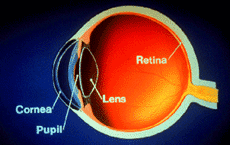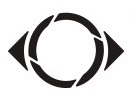How the Eye Works
The normal eye has the ability to receive pictures in the form of light and transmit those images to a part of the brain called the visual cortex, creating the picture that you see.
 The ability to see clearly is determined by the shape of the cornea, the shape of the natural lens and the length of the eye. In the normal eye, these elements work together to focus light rays on the retina. In this situation, a crisp, clear image is transmitted to the brain.
The ability to see clearly is determined by the shape of the cornea, the shape of the natural lens and the length of the eye. In the normal eye, these elements work together to focus light rays on the retina. In this situation, a crisp, clear image is transmitted to the brain.
Light first passes through the cornea, a transparent curved “window” at the front of the eye. The curve of the cornea bends light to focus it through the pupil, a round opening in the center of the iris.
The cornea is the main focusing part of the eye, accounting for approximately 70 per cent of the eye’s focusing power. The lens of the eye is located right behind the pupil. Light focused by the cornea through the pupil is further focused by the lens onto the retina, a light sensitive membrane on the back wall of the eye.
The retina changes the light rays into electrical impulses and sends them to the brain via the optical nerve, where they are translated into visual images.

 Effective March 11th, 2024, we are relocating our office in Concord to 1220 Concord Ave, Suite 290, Concord, CA 94520
Effective March 11th, 2024, we are relocating our office in Concord to 1220 Concord Ave, Suite 290, Concord, CA 94520